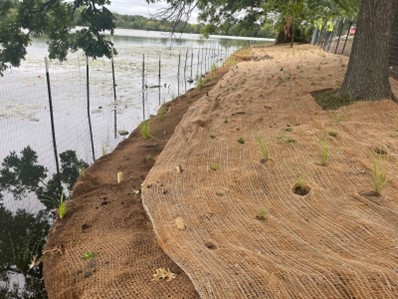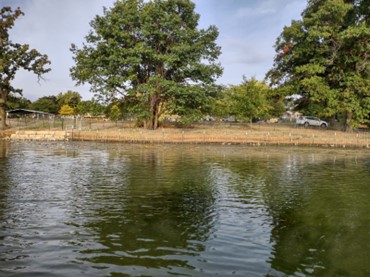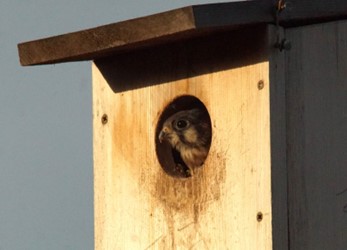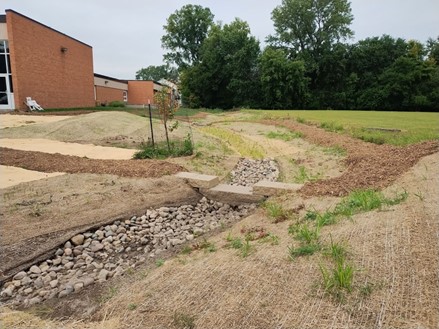Current Projects
The Soil & Water Conservation Division is involved in several projects to assist in conserving and enhancing natural resources in Ramsey County.
Lilydale Regional Park
The Soil & Water Conservation Division has received $925,811 in 2014 flood relief funding from the Minnesota Board of Water and Soil Resources to be used to improve the conditions of Lilydale Regional Park. Saint Paul Parks and Recreation, the park operators, will provide guidance on how to spend the funds as part of efforts by several government agencies to make the park completely open to the public again.
Lilydale Regional Park is a 380-acre park near downtown Saint Paul. The area was originally used in the late 1800s until the 1970s to mine clay and silica. Stormwater runoff into the mining areas has caused landslides and erosion problems. The increased erosion of the ravines and clay pits has led to more dirty sediment moving downstream to Pickerel Lake and the Mississippi River and has created water quality concerns. Additionally, the grounds have become unstable with the potential for sudden collapse from the increased erosion and exposed slopes.
After considerable study of the area including slope stability, soil suction, high risk areas and other factors, project partners are working together to restore the stability of the most vulnerable slopes and ravines. The unique features of the site will be preserved throughout the restoration process. The project will benefit public safety and water quality from a reduction in stormwater runoff.
For more information, email Joe Lochner or call 651-266-7273.
Project resources
Battle Creek Makeover
Although lawns can be lovely recreation areas, maintaining lawn areas can be expensive and not as beneficial as native plants. That’s why seven acres of turf in the southeast corner of the park, along McKnight Road, is being transformed into a natural refuge that will provide scores of benefits for the environment while also saving precious taxpayer dollars.
Many fashions have come and gone over the past few hundred years, but lawns have had staying power. Historically, lawns have served as a status symbol for European aristocrats who showed they were wealthy enough not to need to grow food on every square inch of their property like peasants. In essence, they could afford to waste the space. With world population and consumption of resources steadily increasing, people are starting to question whether this consumptive style makes sense in today’s world. In summary, native plantings offer a sustainable and environmentally friendly alternative to traditional turf grass lawns, promoting ecological balance, water conservation, and overall environmental health.
Converting lawn to prairie makes “cents”—it will save the county money in the long run.
Native plantings require less maintenance once they are established. This reduces the need for fuel, equipment, and labor, resulting in no mowing and lower maintenance costs. Since native plants are often more resistant to local pests and diseases. Native plants are also adapted to local soil and climate conditions, reducing the need for soil amendments and other inputs.
Converting lawn to prairie supports the environment—which supports humans
Something that people tend to forget is that taking care of the environment also protects human health. Native prairie creates oxygen for us to breathe, and the soil filters the water we need to drink. We need to reframe our thinking that taking care of the environment isn’t just a nice thing to do if we get around to it, it’s essential.
Biodiversity and Pollinator Support
Native plants are adapted to local environmental conditions, providing essential habitat for native wildlife such as birds, butterflies, bees, and insects. The statewide effort to bring back the endangered Rusty-Patch Bumblebee’s mantra is ‘plant wildflowers’ to help support local biodiversity. Native plants often have specialized relationships with local wildlife, offering food sources, shelter, and breeding grounds. They can attract a more diverse array of fauna compared to turf grass lawns. Once again, let’s remember that pollinators help make about one-third of the food we eat, like apples, berries, cucumbers, and squash.
Did you know that many human-engineered flowers called “cultivars” often aren’t as beneficial to pollinators because they don’t produce as much pollen and nectar? Many native plants are excellent sources of nectar and pollen, providing crucial food for pollinators such as bees and butterflies. This supports the health of pollinator populations, which are essential for agriculture and ecosystem health.
Climate Adaptation and Water and Soil Conservation
Native plants are adapted to local climate conditions, making them more resilient to weather extremes, including droughts and temperature fluctuations. This adaptability is crucial in the face of climate change and also greatly reduces the need for irrigation. Since many native plants have deep and extensive root systems, they can find their own water and help anchor the soil. These incredible roots also improve soil structure and water absorption when big rains occur.
Aesthetic Appeal
Native plantings showcase a variety of colors, textures, and seasonal changes, providing visual interest throughout the year. Native landscapes reflect the natural beauty of our region, creating a sense of place and connection to the local environment.
Beaver Lake County Park Shoreline Restoration
Ramsey County Soil & Water successfully restored 230 feet of degraded and eroding shoreline on Beaver Lake, located in the Beaver Lake County Park in the southeast portion of the county. Shoreline restoration means returning it to its natural and healthy lake edge ecosystem by replanting native plants that once grew there.
The Project
The process of restoring the shoreline involved placing coconut fiber logs on the shore's edge and planting plants directly into the logs. Over time, the plants will hold the soil in place. In addition, emergent vegetation was planted in the water, and upland species were planted on land to create a buffer. To reduce trampling of the newly planted vegetation, two fishing nodes were created using limestone blocks. The project was completed through the funding and partnership of Ramsey County Parks & Recreation, the Ramsey-Washington Metro Watershed District, and Watershed-Based Implementation Funding from the Board of Soil & Water Resources.
Project Benefits
- Erosion Control: Shoreline restoration helps stabilize the soil along water bodies, preventing erosion caused by waves and storms.
- Water Quality Improvement: Native vegetation in shoreline areas acts as a natural filter, trapping sediments and pollutants before they enter the water. This helps improve water quality by reducing nutrient runoff and contaminants, benefiting both aquatic ecosystems and human water supplies.
- Biodiversity Enhancement: Restored shorelines often incorporate native plants and habitats, providing a more diverse and resilient ecosystem. This, in turn, attracts a variety of wildlife, including birds, insects, and aquatic species, contributing to overall biodiversity.
- Habitat Creation and Preservation: Shoreline restoration projects create habitats for various species, including fish and other aquatic organisms. The restored areas serve as breeding grounds, nurseries, and feeding grounds, supporting the life cycle of many species.
- Aesthetic Improvement: Restoring natural vegetation and habitats along shorelines enhances the visual appeal of the area.
- Climate Resilience: Shoreline restoration contributes to climate resilience by reducing the impacts of extreme weather events. Healthy shoreline ecosystems provide a buffer against storm surges and flooding, helping communities adapt to changing climate conditions.


Reviving Lake Como
Como Lake, a 70.5-acre shallow urban lake located in St. Paul’s 348-acre Como Regional Park, is one of the most popular lakes in the region. Unfortunately, Como Lake has experienced poor water quality for decades due to excessive nutrient inputs from stormwater runoff as well as from internal sources in the lake itself. To help improve the lake, RCSWCD assisted Capitol Region Watershed District (CRWD) by transplanting native vegetation from a carefully selected donor lake. The results so far are promising.
In 2020, CRWD developed the Como Lake Long-term Vegetation Management Plan aimed at restoring and enhancing the native aquatic plant community using an adaptive management approach. The approach was comprised of three steps: controlling the invasive Curly-Leaf Pondweed, re-establishing native plants using donor plants from healthy lakes, and monitoring and adjusting as needed.
To address Curly-Leaf Pondweed, an herbicide called fluridone was used in April 2020 and March 2021. These successful treatments resulted in a 98% reduction in viable “turions,” or overwintering buds, found in bottom sediments in 2021. To re-establish the native aquatic plant community, the partners evaluated various options and determined that transplanting from a donor lake was most feasible. They developed a work plan that involved selecting appropriate species, selecting a donor lake without invasive species, obtaining a transplanting permit, installing nursery areas at key locations, collecting species from the donor lake, and planting or dispersing collected species in nursery areas.
In September 2021, over 500 live plants were transplanted into four 10-foot by 13-foot enclosures. In September 2022 and August 2023, more transplants were added in ten locations. The partners established a monitoring plan to track progress and determine what worked and what didn't. They conducted various surveys, including biovolume surveys, stem count surveys, and vegetation coverage surveys using GoPro videos. The survey results from the first year of monitoring in 2022 showed that the plants were thriving. Some plant species, such as Water Stargrass, Slender Naiad, and Water Celery were more successful than others, and the enclosures were helpful for plant establishment.
The transplanting helped jumpstart native aquatic plant growth in Como Lake and will continue to be monitored to confirm long-term success. The best news is that the water clarity in Como Lake has improved greatly.
To learn more about the lake, visit CRWD’s website.
Kestrel Conservation
Ramsey County Parks successfully hosted nesting American kestrels in nest boxes along Rice Creek, aided by ornithologist Amber Burnette. With federal authorization, Burnette banded the birds for identification. Eight young falcons were banded and later fledged, contributing valuable data for population studies. Ramsey County's habitat management efforts are crucial in combating global avian population declines. The county expresses gratitude to Burnette for her volunteer work and highlights the importance of continued conservation efforts in urban environments.
For more details and to read the rest of the story: Kestrel Conservation Success Soars to New Heights

Sustainable Stormwater Management
The Ramsey County Soil and Water Conservation Division joined forces with Capitol Region Watershed District (CRWD) to partner with Hand-in-Hand Christian Montessori School in Roseville. Together, they embarked on an innovative initiative to design and install a state-of-the-art stormwater management system. This green infrastructure practice serves as a beacon of environmental responsibility, specifically targeting polluted water runoff from the school's expansive parking lot and roof.
The impact of this project is nothing short of impressive, with an estimated 250,000 gallons of water treated annually before entering a storm sewer that ultimately leads to nearby Lake McCarrons in Roseville. To put the significance into perspective, just one pound of phosphorus—commonly found in soil, leaves, and grass clippings—can generate approximately 500 pounds of algae in water bodies. The stormwater management system at Hand-in-Hand Christian Montessori School plays a crucial role in mitigating such environmental risks.
What sets this project apart is not only its environmental impact but also its integration within the school campus. Positioned prominently for all to see, the stormwater management system includes interactive elements, including concrete block “weirs” (low dam-like structures, pictured) that allow students to have an up-close look at the basins without trampling native plantings. Also, the stormwater pre-treatment structure enables students to monitor the amount of sediment, debris, and trash the project is diverting from area waters. These elements are designed to engage students in the importance of sustainable practices. Yet to be installed, CRWD will be adding educational signage to explain the project’s features. This project is a perfect learning opportunity for kids and their adults to understand how personal actions go hand in hand with environmental stewardship.
As the world grapples with the effects of climate change, initiatives like these underscore the increasing importance of green infrastructure. The Hand-in-Hand collaboration serves as a testament to the proactive measures communities can take to address environmental challenges. By instilling a sense of responsibility in the younger generation through hands-on experiences, this project not only benefits the local ecosystem but also contributes to shaping environmentally conscious citizens for the future. Hand in hand, the community and environmental organizations are making strides toward a greener, more sustainable tomorrow.
